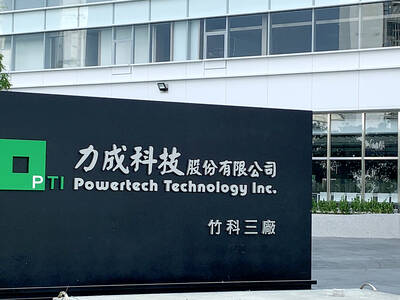For the past three years, Terry Aberhart has watched the spindly, fixed-wing drones zip across the big skies over his farm in Canada’s Saskatchewan province, testing a technology that could be the future of weeding.
Fitted with an artificial intelligence (AI) system, the drones are designed by local start-up Precision AI to spot, identify and kill the weeds without drenching the entire crop in chemicals.
“I’m on the list for one of the first machines when they become available,” said Aberhart, a sustainable farming enthusiast. “The current technology is designed for maximum coverage and to hit everything in the field.”

Photo: Reuters
For decades, crops that require vast space such as corn and wheat have been treated by spraying tractors that would move across farmlands, unleashing waterfalls of herbicide from long arms stretched above the crops, all to zap weeds that are often tiny and scattered about.
Apart from the environmental toll, that conventional spray-it-all approach also results in colossal financial waste. Last year alone, Aberhart spent nearly C$1 million (US$731,074) on herbicides to protect wheat, canola and pulses growing on a slice of prairie larger than Manhattan.
“Even if we could save 50 percent on average, it’s a huge saving,” he said.
The problem of combating weeds in a sustainable way is more urgent today than ever.
Scientists say global warming supercharges the growth of certain weeds that compete for nutrients with crops, threatening food security.
However, every drop of herbicide farmers spray comes with an environmental cost, polluting soil, contaminating drinking water and contributing to a catastrophic loss of biodiversity.
A 2020 study found that prolonged exposure to weed killers — including those approved by regulators — poses a threat to water fleas, a species vital to the aquatic ecosystem.
Pressure is also mounting on global food producers to rethink intensive farming practices; leaders from 195 nations signed a landmark UN-backed agreement last year, pledging to protect and restore at least 30 percent of the Earth’s land and water by 2030.
Precision AI is among a handful of companies turning to advanced technology to address the problem of chemical overuse in agriculture. Founded in 2017 by serial tech entrepreneur Daniel McCann, the company uses images of 15,000 plant species to train computer algorithms to distinguish staple crops, such as corn, wheat and soybeans, from unwanted weeds. The drone’s camera can “see” anything bigger than half a sesame seed and its AI identifies weeds with 96 percent accuracy, spraying the intended target alone.
Precision AI sayd that its approach can reduce herbicide use by as much as 90 percent compared with traditional methods.
The start-up was one of a dozen winners of this year’s BloombergNEF Pioneers award, which aims to spotlight early stage climate tech innovators with game-changing potential.
Precision’s drones are capable of carrying nearly 20 liters per flight and covering about 32 hectares an hour. As the drone flies 1.2m to 1.8m above the ground, its AI system makes real-time decisions and applies herbicides only where needed.
“We can’t continue to do things the way we’ve always done them,” McCann said. “We have to grow food smarter.”
Leveraging robotics and computer technology to assist in agricultural production is not a new concept; researchers at the University of Florida explored the possibility of a robotic orange picker as early as the 1980s.
However, recent technological advancements in AI, combined with worsening labor shortages and growing consumer demand for ethically and ecologically produced food, have accelerated innovation.
“There are a lot of new developments and efforts towards using automated robotic solutions in agriculture,” said Manoj Karkee, a professor specializing in agricultural engineering at Washington State University. “We’re closer than ever to starting utilizing these technologies.”
Precision farming — an umbrella term that covers everything from AI-enabled weeding machines to smart sensor-controlled irrigation systems — is expected to grow from a US$8.5 billion business last year to US$15.6 billion by 2030, consultancy Markets and Markets says.
To get a slice of that action, Israeli start-up Greeneye Technology helps upgrade mainstream sprayers to smarter ones that can identify and target individual weeds. Bosch BASF Smart Farming, a joint venture between two of Europe’s largest conglomerates, has come up with a similar solution.
Precision AI is focused on weed control from the sky with an additional benefit in mind. Unlike conventional spraying tractors and high-tech ground robots that trample anything in their way and compact the soil, drones minimize collateral damage.
That, in turn, could enable farmers to produce more on the same land — good news for a world where at least 50 percent more food is needed by 2050 to sustain a growing population, a 2019 study found.
For now, Precision AI’s drone is operated with supervision from a human pilot, but McCann said that his company is poised to introduce a fully autonomous spraying drone that can take off, fly and land by itself — as long as regulators grant permission.
The start-up plans to commercialize its on-demand spraying service next year, allowing farmers to book as needed — not dissimilar to how consumers order an Uber. It would also sell the spraying drone to farmers who want more control over their crop management and charge a fee for its AI operating software on a pay-as-you-go basis.
That business potential has attracted investors including At One Ventures and BDC Capital, who have poured more than US$20 million in venture funding into the company.
Precision AI was also among eight start-ups selected earlier this year by Moline, Illinois-based Deere & Co, one of the world’s biggest farm machinery makers by revenue, to team up on the exploration of agricultural technology.
However, not everyone is convinced that future farming will be ruled by flying robots.
Mark Siemens, an associate professor in biosystems engineering at the University of Arizona, said that agricultural drone makers still need to prove their technology, especially at scale.
There is also the issue of regulatory hurdles. Precision AI is first targeting North America, where large-scale farming is common, but Canada has yet to give its regulatory blessing to commercial drone-based weed control.
In the US, where Precision AI plans to make its commercial debut next year, lawmakers have given the green light for agricultural spray drones used by licensed operators — but they have done so with a long checklist.
“The legal framework is still pretty challenging,” Karkee said.
On top of that, agricultural drone makers including Precision AI could be given the cold shoulder from those they mean to help.
Aberhart said that it would require “a big shift in mindset and mentality” for the farming community to switch over from the blanket spraying practice that has dominated the industry for decades.
The first converts would be taking a big risk. After all, if weed management fails, it can ruin a season.
Yet Aberhart said that the transition is likely a question of when, rather than whether.
“It costs a farmer money to spray. So why would we want to spend more money if we don’t have to?” he asked.

Taiwan Semiconductor Manufacturing Co (TSMC, 台積電) has secured three construction permits for its plan to build a state-of-the-art A14 wafer fab in Taichung, and is likely to start construction soon, the Central Taiwan Science Park Bureau said yesterday. Speaking with CNA, Wang Chun-chieh (王俊傑), deputy director general of the science park bureau, said the world’s largest contract chipmaker has received three construction permits — one to build a fab to roll out sophisticated chips, another to build a central utility plant to provide water and electricity for the facility and the other to build three office buildings. With the three permits, TSMC

The DBS Foundation yesterday announced the launch of two flagship programs, “Silver Motion” and “Happier Caregiver, Healthier Seniors,” in partnership with CCILU Ltd, Hondao Senior Citizens’ Welfare Foundation and the Garden of Hope Foundation to help Taiwan face the challenges of a rapidly aging population. The foundation said it would invest S$4.91 million (US$3.8 million) over three years to foster inclusion and resilience in an aging society. “Aging may bring challenges, but it also brings opportunities. With many Asian markets rapidly becoming super-aged, the DBS Foundation is working with a regional ecosystem of like-minded partners across the private, public and people sectors

BREAKTHROUGH TECH: Powertech expects its fan-out PLP system to become mainstream, saying it can offer three-times greater production throughput Chip packaging service provider Powertech Technology Inc (力成科技) plans to more than double its capital expenditures next year to more than NT$40 billion (US$1.31 billion) as demand for its new panel-level packaging (PLP) technology, primarily used in chips for artificial intelligence (AI) applications, has greatly exceeded what it can supply. A significant portion of the budget, about US$1 billion, would be earmarked for fan-out PLP technology, Powertech told investors yesterday. Its heavy investment in fan-out PLP technology over the past 10 years is expected to bear fruit in 2027 after the technology enters volume production, it said, adding that the tech would

RUN IT BACK: A succesful first project working with hyperscalers to design chips encouraged MediaTek to start a second project, aiming to hit stride in 2028 MediaTek Inc (聯發科), the world’s biggest smartphone chip supplier, yesterday said it is engaging a second hyperscaler to help design artificial intelligence (AI) accelerators used in data centers following a similar project expected to generate revenue streams soon. The first AI accelerator project is to bring in US$1 billion revenue next year and several billion US dollars more in 2027, MediaTek chief executive officer Rick Tsai (蔡力行) told a virtual investor conference yesterday. The second AI accelerator project is expected to contribute to revenue beginning in 2028, Tsai said. MediaTek yesterday raised its revenue forecast for the global AI accelerator used